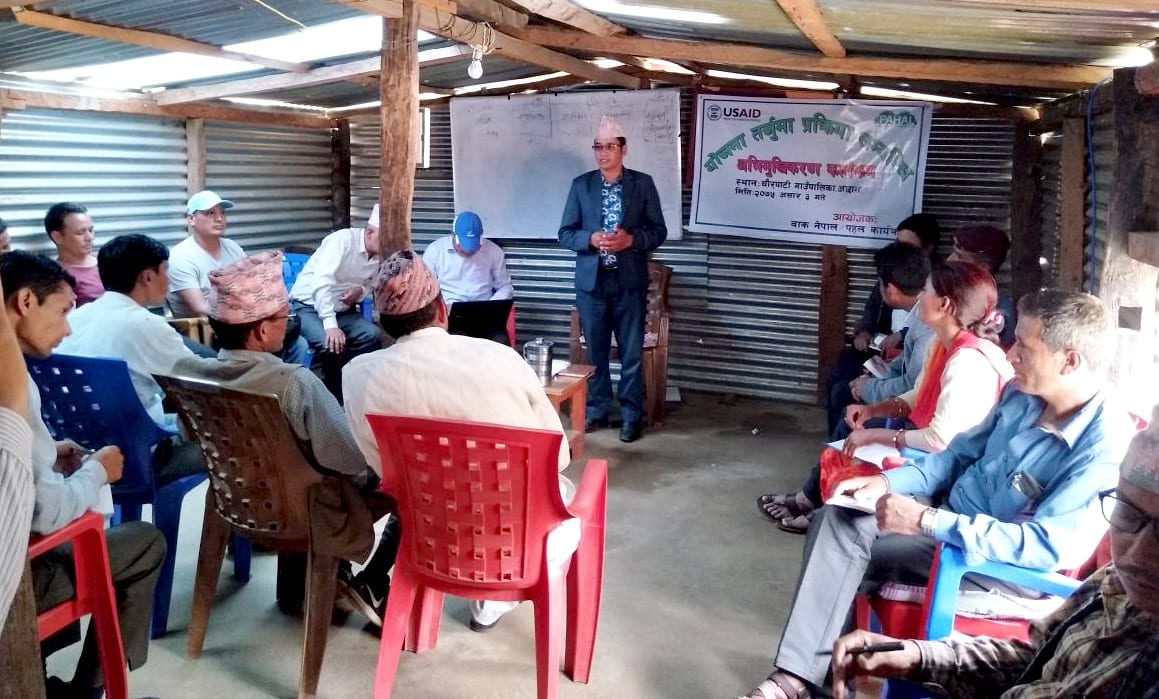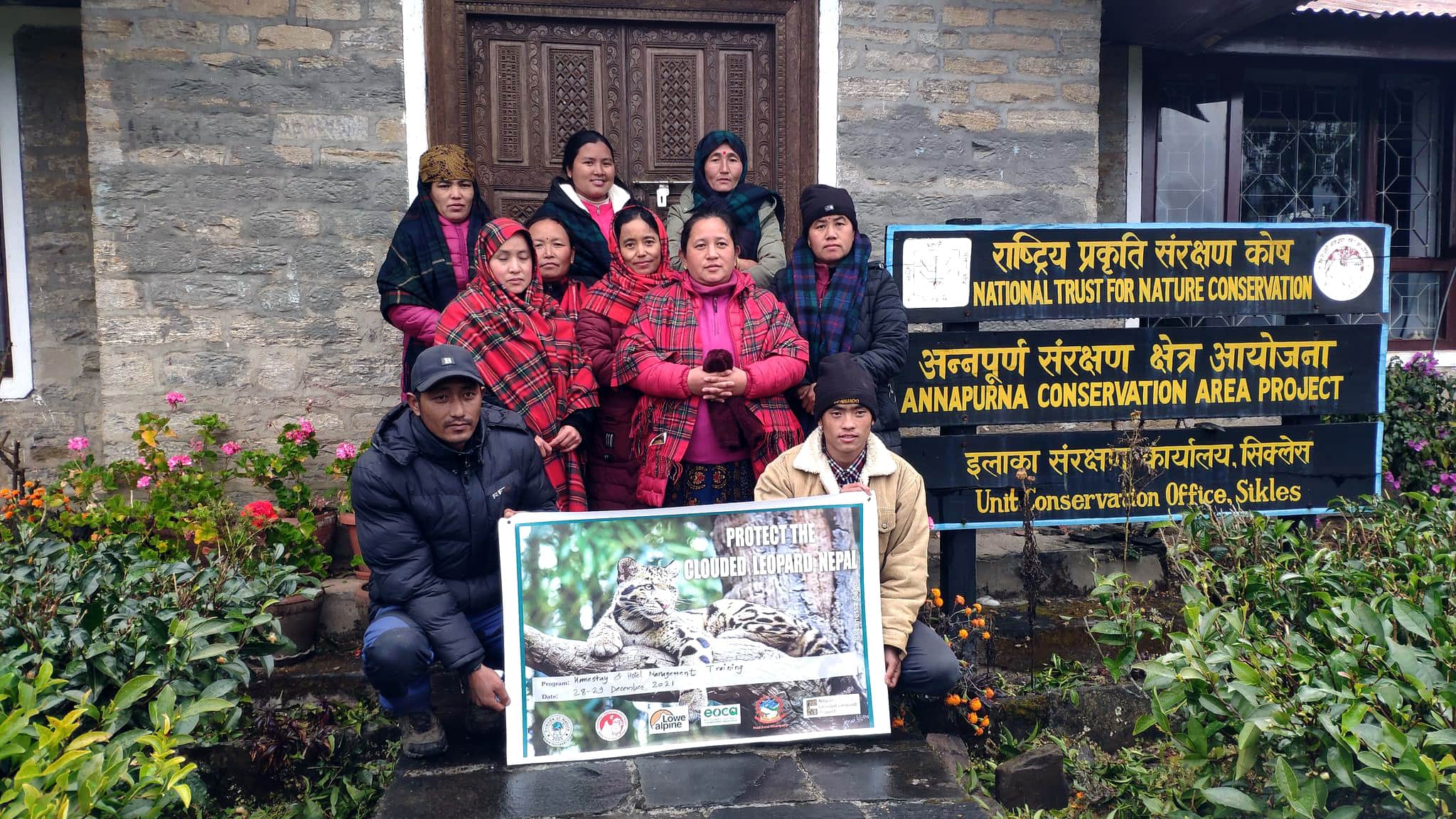Several local governments have done exemplary work by becoming engaged in wildlife and ecological conservation.
Maheshwar Acharya |CIJ, Nepal
Sikles and Tanting in the Himalayan region in Madi Rural Municipality in Kaski district are the clouded leopard’s habitat (dhwasey chituwa). Although the local elderly of Sikles in Ward-1 and Tanting in Ward-2 told stories of the leopard, they did not know which species it was.
Only two years ago, when conservationists Raju Acharya and Yadav Ghimire conducted a study, the area was identified as a clouded leopard habitat.
“The animals and vegetation found here have a local name. But the clouded leopard does not have a local name,” said ward-2 chairperson Ekjang Gurung.
The rural municipality has supported research on the clouded leopard to conserve it. Moreover, the rural municipality has used the image of the clouded leopard in its official logo. As part of the conservation plan, schools of both wards have constituted nature clubs.

Members of Chaurpati Rural Municipality discuss the inclusion of conservation in their regular programme. Photo: Chaurpati Rural Muncipality
As per Gurung, the locals are encouraged to practice conservation, the youth are provided with a ‘nature guide’ training, and a homestay programme is being run in the wards.
“The ward has started work on conservation while attracting tourists. The youth have got work as nature guides, and mothers are running homestays,” said Prakash Gurung, a local conservation activist.
Eleven guns from the village have been handed over to the district administration. Those dependent on hunting for livelihood have been given alternative employment opportunities.
“The youth have got work as tourist guides after receiving training,” Gurung said, adding, “Their incomes have increased due to tourism.”
An Act to save fish
Upon realizing that some local fish species are at risk of extinction, some local levels in Dang district have started work by forming a fish conservation committee. The committee has been working for the past three years, with the active involvement of women, to conserve the fish in simsar and water bodies in Gadhwa, Rajpur and Rapti rural municipalities.

Rapti Municipality in Dang district has formed an Act for the conservation of fish and other aquatic beings. Photo: Human Welfare and Environment Conservation Centre
The Rapti Rural Municipality has banned the unauthorized and unnatural harvesting of fish by forming a “Water-based Biodiversity Act”. “Fish and other aquatic beings were nearing extinction as people harvested them using electric shock or poison. But we have put an end to such a practice after increasing public awareness and bringing the Act into effect,” said Pateshwari Prasad Chaudhary, the coordinator of the Fish Conservation Committee of four wards of Rapti Rural Municipality.
The rural municipality has also started to build a fish museum in Ward-5. With local committees working actively towards fish conservation, the number of fish species, organisms, and vegetation have improved. “After we started harvesting fish naturally, the number of ghongi, shankhe kira and sipi has increased, and algae has increased,” Chaudhary said.
Local employment has risen after the rural municipality took ownership of the programs that had initially begun through the initiatives of conservation institutions.
Homestay for conservation
The Amaltari village, located in Kawasoti in Nawalpur District, in the buffer zone of Chitwan National Park, is famous for its homestay services.
“Each home has been earning between Rs30,000 to Rs50,000 through homestay,” said Dhaniram Gurau, the homestay manager at Amaltari Buffer Zone Community Homestay. “Earlier, the rhinos and spotted deer (chittal) of the national park used to cause damage to human lives, cattle and crops. Now, the community forest has grassland and a water body, which has reduced the hardships caused by wild animals. The number of tourists visiting to see birds and rhinos has increased after the jungle became better.”

Women in Sikles receive training on conducting a homestay. Photo: Raju Acharya
Although the conservation work was begun before the constitution of the local level in Amaltari, the municipality has come aboard now.
Apart from tourism, which has been considered a supporting pillar for conservation, the municipality has also supported the community-based initiative against smuggling and hunting.
The municipality has also provided financial support to the cultural museum that is under construction.
“The municipality has been supporting on a need basis as of now, but it will be of great help if it includes the issue of inclusion in its regular programme,” Gurau said, adding, “The work does not seem sustainable if we depend only on the budget allocated by the national park.”
The municipality has been creating employment opportunities for the youth by training them to be vigilant against hunting and smuggling wildlife. “The children here do not play with a slingshot, as everyone is conscious about conservation here,” said Gurau.
Diversity conservation through pond
Ghorahi Municipality is active in conserving water sources. The municipality has created 30 artificial ponds in its first five-year term. “Fishery has improved after the construction of artificial ponds. It has been possible to supply water to arable lands through lift irrigation and surface irrigation,” said Narulal Chaudhary, mayor. “It has boosted eco-tourism as well.”
He said that building a pond by making minimal use of cement and concrete proved beneficial. “Earlier, somebody or the other would file cases in courts due to the conflict over water, and people would fight for the same. But things have changed now,” Chaudhary said.

Women active in fish conservation in Gadhwa, Rajpur and Rapti rural municipalities. Photo: Human Welfare and Environment Conservation Centre
The water shortage problem was solved after the building of the pond.
Lamahi Municipality in Dang district has built four big ponds with its resource and coordination of the provincial government and other institutions. It is planning to build three more ponds. “The usage and significance of a pond are so wide,” said Kul Bahadur Khatri, mayor of the municipality. “The water level has risen after the water source conservation in a place where there used to be a water shortage. We have started crocodile conservation in Gupti pond, which we had built.”
The increase in ponds has also led to a rise in the number of birds. The building of the ponds has also provided water for lemon cultivation and goat rearing in wards 4 and 5.
Similarly, Hariharpurgadhi Rural Municipality in Sindhuli has conserved small streams and water sources and built over a hundred ponds. According to Karsang Lama, the chairperson of the rural municipality, the ponds have increased the availability of water, irrigated cultivable land, helped start fishery, and cultivate unseasonal crops.
“This has raised the locals’ incomes,” said Lama, adding, “We have built ponds in 2-4 kattha of land by using local technology. This method, which is not too expensive, has played a significant role in ecology and agriculture.”
Bagchaur Municipality in Salyan has built a pond in ward-3. According to Tikaram KC, chairperson of the ward, “Almost 700 households have benefited from the pond. We built 50 recharge ponds initially, and now we are building an irrigation canal.”
A day for conservation
Chaurpati Municipality in Achham district has begun conservation work with “One day for ecological conservation, and 364 days oneself”. According to Harka Bahadur Saud, the chairperson of the rural municipality, “Even if we work towards ecological conservation for a day, we help conserve water, jungle, land, animals and birds. So we have started a pond initiative with the participation of locals.”
As part of this initiative, the rural municipality invites all locals of the tole to be involved in making a pond. “We have made 700 small and big ponds as of now,” said Saud, adding, “Pond have short-term and long-term benefits. They help conserve water sources, grow plants in arid hilltops, irrigate arable land, and conserve birds and other beings.”
The road ahead
The work done by local levels towards conservation when infrastructure is the mainstay of development while ecological concerns remain sidelined is praiseworthy. According to Jhamak Karki, a conservationist, “The unavailability of water in the jungle is one major cause of human-wildlife conflict. The work by the local levels towards building ponds helps reduce the conflict.”
According to Raju Acharya, a conservationist, the representatives of most of the local levels are unaware of conservation, and their priorities lie elsewhere. However, the work done by some local levels is worthy of emulation, although, according to Acharya, such efforts are insufficient as yet.

Conservationist Yadav Ghimire training students of the environment on ecological conservation.
According to Jhamak Karki, an activist and teacher, local levels should include conservation issues in their regular programmes. “It is only when the local levels participate in conservation that the conservation efforts become realistic and effective. This is also the global practice.”
According to Krishna Bhushal, an ornithologist, while some local levels have given priority to conservation, others have failed to do the same.
However, as local levels are pressured to focus on livelihood and economic gain, they use their resources on these issues.
According to Shanta Raj Gyawali, a conservationist associated with World Wildlife Fund, if local levels make an effort, the local people become involved in conservation activities. “The locals are knowledgeable about the animals and ecology in their surroundings, so their involvement has a big role in conservation.”
It is also necessary to use the income of the community forest in conservation activities, said Sabina Koirala, a conservation enthusiast. “As of now, community forests have been developed from the point of view of timber production. But the concept of the balanced forest has not taken form yet,” Koirala said, adding, “In the coming days, it is necessary to develop community forests as locations for management of animals and food, which will help reduce human-wildlife conflict.”
According to Naresh Subedi, a conservationist associated with the Nepal Nature Conservation Trust, it is necessary for the local levels to become involved in wildlife conservation and national park management, as against the established practice of only the federal level becoming engaged in such practices.

Sikles and Tanting in the Himalayan region in Madi Rural Municipality in Kaski district are the clouded leopard’s habitat.
“There is a flawed understanding that development means roads, electricity, employment, and access to economic resources. But development also means conserving animals and ecology. There should arise a situation where those who vow to work towards ecological conservation get votes in elections,” Subedi said.
In Subedi’s view, those representatives who have had prior experience in conservation have done admirable work in protection.
Contradictions
The Local Government Operation Act, 2074 has mandated local levels to formulate policies, laws, guidelines and plans for drinking water, cleanliness, health, agriculture, irrigation, ecological diversity, environment and climate change, and ensure the implementation, monitoring and regulation of the same.
The transfer of power from the federal to the local level is still ongoing. However, the conflict and uncertainty regarding the mandate of the three levels of the government continue to date.
The constitution has mandated the local levels to conserve land and watersheds, local water management, small water resources infrastructure reconstruction, refilling, maintenance and maintenance. However, it has mandated the federal centre to prepare policies, action plans, laws, and guidelines for conserving and managing water resources, climate change adaptation, and the environment. There is a need to solve this contradiction in the days to come.



